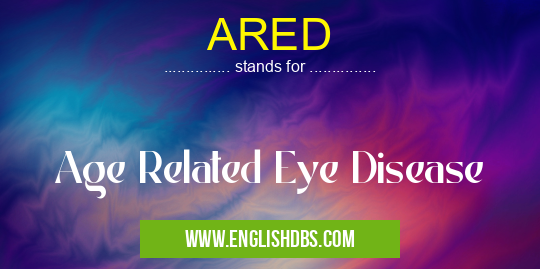What does ARED mean in DISEASES
ARED is a term used to describe a group of eye conditions that are more common in older adults. These conditions can cause vision loss and other eye problems. The most common types of ARED are macular degeneration and cataracts.

ARED meaning in Diseases in Medical
ARED mostly used in an acronym Diseases in Category Medical that means Age Related Eye Disease
Shorthand: ARED,
Full Form: Age Related Eye Disease
For more information of "Age Related Eye Disease", see the section below.
- ARED (Age-Related Eye Disease) refers to a group of eye conditions that develop over time, primarily affecting individuals aged 50 and older.
What does ARED Stand for?
- Age-Related Eye Disease
Types of ARED
- Age-Related Macular Degeneration (AMD): Affects the central part of the retina, causing blurred vision and potential vision loss.
- Cataracts: Clouding of the lens, leading to decreased vision and glare sensitivity.
- Glaucoma: Damage to the optic nerve, causing peripheral vision loss and potentially blindness if left untreated.
Causes and Risk Factors
- Age: Primary risk factor for ARED
- Genetics: Family history increases the risk
- Smoking: Damages eye tissues
- Exposure to sunlight: UV radiation can harm the eyes
- Poor diet: Deficiencies in certain nutrients, such as antioxidants and omega-3 fatty acids
Symptoms of ARED
- Blurred vision
- Difficulty reading
- Distorted vision
- Loss of peripheral vision
- Increased glare sensitivity
- Eye pain
Diagnosis and Treatment
- Comprehensive eye exam: Includes vision testing, pupil dilation, and retinal imaging
- AMD: Anti-angiogenic therapies, laser surgery
- Cataracts: Lens replacement surgery
- Glaucoma: Eye drops, laser surgery, trabeculectomy
Prevention
- Regular eye exams: Early detection and treatment are crucial
- Lifestyle modifications: Quit smoking, wear sunglasses, manage blood pressure
- Healthy diet: Consume plenty of fruits, vegetables, and whole grains
- Antioxidant supplements: May help protect against AMD (e.g., AREDS formula)
Essential Questions and Answers on Age Related Eye Disease in "MEDICAL»DISEASES"
What is Age-Related Eye Disease (ARED)?
What causes ARED?
The exact cause of ARED is not known, but it is thought to be caused by a combination of factors, including aging, genetics, and environmental factors. Some of the risk factors for ARED include:
- Age: The risk of ARED increases with age.
- Family history: People with a family history of ARED are more likely to develop the condition.
- Race: African Americans and Hispanics are at a higher risk of ARED than whites.
- Smoking: Smoking cigarettes increases the risk of ARED.
- Obesity: Obese people are more likely to develop ARED.
- Sun exposure: UV rays from the sun can damage the eyes and increase the risk of ARED.
What are the symptoms of ARED?
The symptoms of ARED can vary depending on the type of condition. Some of the most common symptoms include:
- Blurred vision
- Difficulty seeing in low light
- Distorted vision
- Flashes of light or floaters
- Loss of central vision
- Pain or redness in the eyes
How is ARED diagnosed?
ARED is diagnosed through a comprehensive eye exam. During the exam, your doctor will ask about your symptoms and medical history. They will also perform a physical examination of your eyes and use special instruments to check your vision and eye health.
How is ARED treated?
The treatment for ARED depends on the type of condition. Some of the most common treatments include:
- Eye drops or injections: These medications can help to slow the progression of ARED.
- Laser surgery: This surgery can be used to treat certain types of macular degeneration.
- Cataract surgery: This surgery can be used to remove cataracts and improve vision.
- Lifestyle changes: Making healthy lifestyle changes, such as quitting smoking, eating a healthy diet, and exercising regularly, can help to reduce the risk of ARED.
Final Words:
- ARED encompasses a range of eye conditions that can significantly impact vision in older adults.
- Understanding the causes, risk factors, and symptoms of ARED is essential for early detection and treatment.
- Regular eye exams, lifestyle changes, and preventive measures can help maintain eye health and reduce the risk of developing ARED.
ARED also stands for: |
|
| All stands for ARED |
